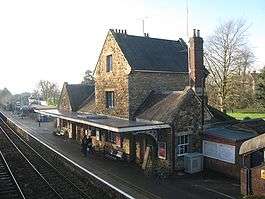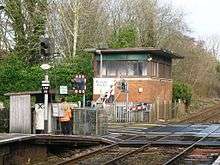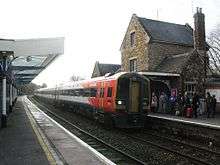Sherborne railway station
| Sherborne | |
|---|---|
 | |
| Location | |
| Place | Sherborne |
| Local authority | West Dorset |
| Coordinates | 50°56′38″N 2°30′47″W / 50.944°N 2.513°WCoordinates: 50°56′38″N 2°30′47″W / 50.944°N 2.513°W |
| Grid reference | ST640161 |
| Operations | |
| Station code | SHE |
| Managed by | South West Trains |
| Number of platforms | 2 |
| DfT category | D |
|
Live arrivals/departures, station information and onward connections from National Rail Enquiries | |
| Annual rail passenger usage* | |
| 2009/10 |
|
| 2010/11 |
|
| 2011/12 |
|
| 2013/14 |
|
| 2014/15 |
|
| History | |
| Original company | Salisbury and Yeovil Railway |
| Pre-grouping | London and South Western Railway |
| Post-grouping | Southern Railway |
| 1860 | Opened |
| National Rail – UK railway stations | |
| * Annual estimated passenger usage based on sales of tickets in stated financial year(s) which end or originate at Sherborne from Office of Rail and Road statistics. Methodology may vary year on year. | |
|
| |
Sherborne railway station serves the town of Sherborne in Dorset, England. It is situated on the London Waterloo to Exeter line, 118 miles (190 km) from London. Opened in 1860, it is currently operated by South West Trains.
History
The station was opened by the Salisbury and Yeovil Railway (S&YR) on 7 May 1860, when the company extended its line from Gillingham to Sherborne. A level crossing across the line was at the east end of the platforms, and the goods yard with a goods shed at the west end; this and the main buildings were on the north side of the line to be nearer the town. Another siding on the other side of the line served the town’s gas works which had been established in 1836. A signal box was erected on the east side of the level crossing and to the south of the line in 1875.[1]
The S&YR never operated any trains, instead they were provided by the London and South Western Railway, which bought out the S&YR in 1878. In 1923 this became part of the Southern Railway, which in turn was nationalised in 1948 to become the Southern Region of British Railways.
In 1960 the signal box was replaced by a new one on the opposite side of the line, but after this a decline set in. From 1963 the line was transferred to the Western Region, and in that year the Reshaping of British Railways report was published. The smaller stations were soon closed, and most trains beyond Exeter St Davids were diverted to other routes. The gas works had stopped receiving coal in 1957 and all goods traffic was stopped from 18 April 1966. On 7 May 1967[1] the 21 miles (34 km)[2] to Chard Junction was reduced to single track, but this proved a mistake and the double track was restored as far as Yeovil Junction on 1 October. The signal box was closed on 4 January 1970 when the level crossing was converted to lifting barriers which were for many years controlled by a member of staff from a panel at the end of the eastbound platform.[1] In March 2012 a modern signalling system for the Salisbury-Exeter line was commissioned and the line, including crossings, is now controlled remotely by the Basingstoke Area Signalling Centre.[3] Remote control of the crossing eliminated the need for constant staff presence at the station during train operating hours, allowing South West Trains to reduce the hours of ticket office staffing.[4]
| Preceding station | Historical railways | Following station | ||
|---|---|---|---|---|
| Milborne Port | London and South Western Railway London Waterloo to Devon and Cornwall |
Yeovil Junction | ||
| London and South Western Railway Salisbury to Yeovil |
Yeovil Town | |||
Description

The entrance and offices are on the northern platform which is served by trains going towards London. A large canopy covers much of the other platform. This is normally reached by crossing a footbridge, but people who find this difficult to use can cross the track under the supervision of the signaller who operates the level crossing. The old signal box still stands on the other side of this, and at the other end of the station can be seen the old goods shed.[1]
The station buffet appeared in a list of "highly commended" station cafes published in The Guardian in 2009.[5]
Services

South West Trains operate hourly throughout most of the week between Exeter St Davids, Sherborne, Salisbury and London Waterloo station. Services are timetabled to pass at Sherborne but the double track provides some flexibility should one of them be running late.[6]
| Preceding station | |
Following station | ||
|---|---|---|---|---|
| Templecombe | South West Trains West of England Main Line |
Yeovil Junction | ||
See also
| Wikimedia Commons has media related to Sherborne railway station. |
References
- 1 2 3 4 Phillips, Derek; Pryer, George (1997). The Salisbury to Exeter Line. Sparkford: Oxford Publishing Company. ISBN 0-86093-525-6.
- ↑ Jacobs, Gerald (2005). Railway Track Diagrams Book 3: Western. Bradford-on-Avon: Trackmaps. ISBN 0-9549866-1-X.
- ↑ "Invensys Rail Awarded Salisbury to Exeter Signalling Recontrol Contract". 25 May 2011. Retrieved 27 April 2012.
- ↑ http://www.thisisdorset.co.uk/Sherborne-railway-station-ticket-office-cuts/story-15362773-detail/story.html
- ↑ Wills, Dixe (2009-05-12). "Ten of the best railway cafes". Guardian. Retrieved 2009-06-30.
- ↑ "Table 160: London to Salisbury and Exeter" (PDF). Electronic National Rail Timetable. Network Rail. December 2009. Retrieved 2009-12-14.